VOLTERRA
Volterra.pdf version for downloading and printing (10 pages)
A stern but spectacular grey hilltop Etruscan town beyond St Gimignano with good mediaeval buildings and museums; needs two visits to do it justice.
Just over an hour’s drive from Barontoli. Drive up to the top and, if there is room, park in the multistory underground carpark on the right just before you reach the bus terminal near the Porta all’ Arco and Piazza dei Martiri della Liberta.
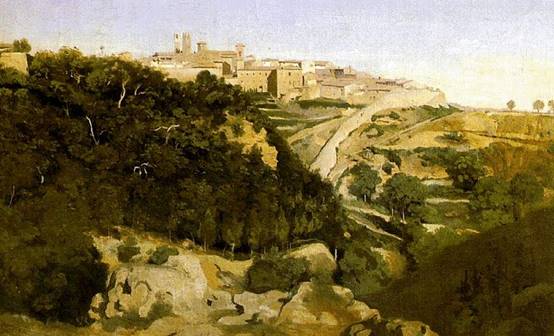
Volterra painted by the French artist Jean-Baptiste Corot (1796-1875)
In pre-Roman days, Volterra was one of the biggest and richest Etruscan towns, and some of the old Etruscan walls are still visible outside the present much smaller mediaeval town which grew up in the 12th and 13th centuries. There is little sign now of the prosperous and busy countryside of Etruscan times, but the mediaeval town remains largely intact. Perched on a craggy hilltop with vast views over bare grey hills, it is windswept and rainswept, often cool in summer and icy in winter. Its inhospitable position made it a good fortress in times past; Volterra maintained real independence until 1472, when it was finally sacked and taken by Florence (long after Siena had effectively been subjugated). Maybe its position is also what decided the authorities in more modern times to put Tuscany's main prison (in the fortress built by the Medici after Volterra fell to the Florentines) and main lunatic asylum there.
Volterra's massive and austerely attractive buildings all crowd in on each other, and both its two squares are rather cramped; there is none of the space and light and grace of its gayer neighbour, San Gimignano. But it has a sombre beauty, only slightly marred by the multiplicity of garish shops selling alabaster objects to the tourists (Volterra's economy has benefitted from nearby alabaster and salt mines since at least 800 BC). There are at least four museums and several churches that should be seen.
Piazza dei Priori
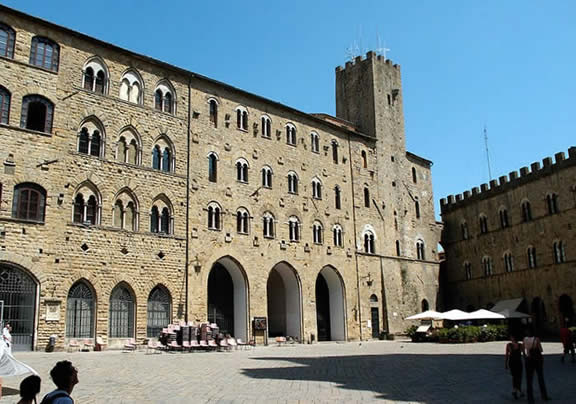
Piazza dei Priori (photo via Wikimedia)
The main square is entirely surrounded by mediaeval or pseudo-mediaeval buildings, the genuine ones all of roughly the same early 13th century period. The south-west side of the square is dominated by the Palazzo dei Priori, the oldest Town Hall in Italy, built between 1208 and 1257 (although the first floor windows have been altered and the top of the tower is 19th century). The Council Chamber (Sala del Consiglio Comunale), on the first floor up two steep flights of steps, can be visited between 10.30 and 17.30 (modest charge). There is a rather damaged 14th century fresco of the Annunciation on the end wall, but otherwise the decoration is modern, but the shape is unchanged and there is a certain fascination in standing in a room that has been used by the city council almost continuously for over 800 years. In the next room, on the left wall, there is a bit of detached fresco with a rather beautiful painting by Luca Signorelli 1441-1523) of St Jerome. The original colour has almost completely faded, which serves to accentuate the skill of the draftsmanship.
The black and white stripy wall next to the Palazzo dei Priori belongs to one of the transepts of the Duomo, and beyond that is the 14th century Palazzo Vescovile, the Bishop's Palace. On the next side of the square, there is another old Palazzo (now the Cassa di Risparmio di Volterra). It was originally a seminary, and has been much modified since mediaeval times but still retains a general mediaeval look. Facing the Palazzo dei Priori are more 13th century buildings. On the left, with a crenellated tower, is an ancient prison; then the Palazzo del Podestà with an arcaded ground floor; and then the Palazzo Pretorio, the tower of which is known as the Torre del Porcellino from the small pig on a bracket to the right of the top window. The Palazzo on the final side of the Piazza is a modern copy of a mediaeval building, but looks almost more genuine than some of the older ones.
Duomo (Cathedral)
The Duomo (closed over the lunch hour) is behind the Palazzo dei Priori, in its own little square (although it can be entered from the Piazza dei Priori through a side door in the stripy transept wall. It dates from the 12th century, with a Romanesque Pisan-style blind arcade at the top of its facade (the elegant doorway was added later, in the 16th century). Inside, the Duomo was thoroughly done over in the 16th century, and not many Romanesque traces remain apart from the general basilica shape and the two rows of columns down the main aisle. The columns, which at first sight look like pink granite, are in fact painted stucco, as are the black and white stripes. There is a particularly magnificent painted ceiling dating from the 1580s. The overall effect is of elegance and order.
There are several good paintings and sculptures (with descriptions in English):
- in the middle chapel of the left aisle there is a quite beautiful painting of the Annunciation attributed to Fra Bartolommeo (1497), with a spacious Tuscan landscape shining through the door in the middle;
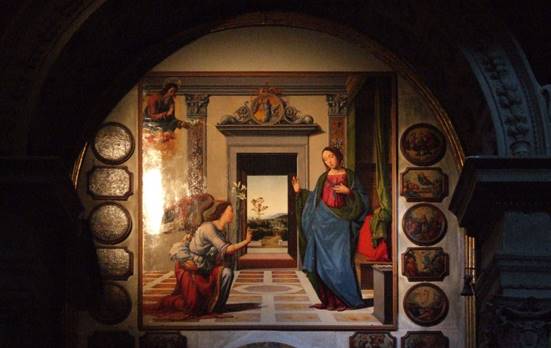
- the pulpit was built in the l6th century at the same time as the makeover of the church, but using 12th century panels: the Last Supper on the front (particularly good, with Judas being egged on by a devil-like creature under the table - according to St Luke's gospel the devil had entered Judas before the latter's betrayal of Christ); Abraham sacrificing Isaac on the back; and the Annunciation on the side;
- in the second chapel of the left transept is a fine painted wooden statue of a rather anxious-looking Madonna and Child by Francesco di Valdambrino (early 1400s);
- on either side of the altar are two serene-faced stone angels kneeling on top of elaborate Gothic columns; they are by Mino da Fiesole (mid-15th century), who was also responsible for the carved tabernacle above the rather hideous 19th century altar;
- in the south transept, to the right of the altar, is an extraordinary and moving life-size group in carved and painted wood of the Deposition of Christ from the Cross, which looks quite modern, with its stylized attitudes and long mournful faces, but in fact dates from 1228. It has recently had irs painting restored, to rather garish effect, but probably bringing it close to what it looked like 800-odd years ago;
- in the niches of the separate Lady Chapel by the main entrance, there are a number of full size 15th century terracotta figures - the Adoration of the Magi on the right and the Nativity on the left. The left hand niche is also decorated with delightful if somewhat faded frescoes by Benozzo Gozzoli (1420-1497), the artist of the Palazzo Medici Riccardi in Florence.
Outside the Duomo, pause to admire the 15th century campanile of the Duomo; the hospital of Santa Maria Maddalena with a Renaissance arcade; and the 13th century octagonal Baptistery, a simple building with a touch of Sienese black and white stripiness. The elegant marble font to the right of the altar was designed for the Baptistery by Andrea Sansovino in 1502, but replaced by the current rather grander but less interesting one in the mid-18th century.
Pinacoteca and Museo Civico
At No 1 via Sarti (out of the main square along via Ricciarelli and right down via Buonparenti). Open 0900-1900 daily in summer and 0900-1300 in winter. Combined ticket with the Museo di Arte Sacra and the Etruscan Museum.
It has a small but interesting collection of mostly Sienese and Florentine paintings, including a stirring mannerist masterpiece by Rosso Fiorentino. There are good signs in English.
Room 1 on the first floor has some 11-12th century capitals, including one of three animals eating an unfortunate man from several directions at once.
Room 2 has a small, damaged but beautiful painting of the Madonna and Child and a crucifix, both 14th century Sienese. Also a polychrome wooden statue of the Madonna and Child with lovely life-like faces, and a painting of Saints Giusto and Ugo (Just and Hugo), all of the same period. There are another couple of saints painted by Taddeo di Bartolo (1362-1422), but these are hack's works - note how St Nicholas of Tolentino with the designer stubble and St Peter with his key have identical faces - only the trimmings have been changed like a Barbie doll. There is a much better Taddeo di Bartolo in Room 3: a polyptych of the Madonna and Saints dating from 1411.
Nothing of interest in the little chapel or the next room, but Room 6 has a wonderfully lively and colourful polyptich by a Portuguese painter, Alvaro Pirez (active 1411-1434), quite different in style from the Italian paintings that we have been looking at. The saints are, from the left, St Nicholas the Bishop; St John the Baptist; St Christopher (note the fish at his feet caught up from his crossing of the river), and St Michael (with a particularly tiny dragon, more like a small dog). Note also the Arab figures in the lunettes above, and the Christ-Child is actually feeding his goldfinch rather than, as so often in Italian painting, clutching it in an uncomfortable-looking grip.
Room 7 has more 15th century wooden figures, and Room 8 has a rather fascinating painting of an almost Picasso-esque long-necked Madonna, by Stefano di Antonio Vanni (1457), quite unlike any of the other representations of the Virgin nearby. There is some not very interesting pottery in a cupboard.
Room 9 has some saints by Neri di Bicci (1477), and Room 10 a charming predella by Benvenuto di Giovanni (1436-1518) of scenes from the life of the Virgin - her birth, presentation at the temple, marriage and assumption, all full of interesting detail: dogs, horses, people chatting. The marriage in particular is a wonderful scene - one can just imagine a mediaeval wedding looking like that. There is also a large 15th century Nativity by a Florentine artist, Benvenuto di Giovanni del Guasto, with some interesting detail – God above surrounded by angels in insufferably pious attitudes and thre shepherds to the right, first been awoken by an angel and then appearing with thewir dog at the stable.
Room 11 has a marvellously accomplished Christ in Glory with Saints Benedict, Attinia, Greciniana and Romualdo, set in a beautiful Tuscan landscape – note the giraffe by the lake adding an exotic touch; it is by Domenico di Ghirlandaio (1449-1492). Saints Attinia and Greciniana were pre-Christian Etruscan holy figures whose worship persisted so strongly after Volterra was converted to Christianity that the Church thought it politic to enrol them as Christian saints. In the same room a painting by Leon da Pistoia already shows the rich colours and simple background of the mannerists - no elaborate landscape here to distract attention from the main scene.
The real mannerist masterpiece is, however, the Deposition from the Cross (1521) by Rosso di Fiorentino in Room 12. This, one of the earliest mannerist works, is a great painting which caused as much of a scandal as the Impressionists or the cubists in their time. Contrast it with the Luca di Signorelli picture of the Madonna and Child with Saints (1491) in the same room, itself a great painting, not much earlier but in the old style, its calm figures carefully posed against an exquisitely drawn background - whereas the Deposition has no background, roughly drawn figures, huge splashes of colour, all adding up to a tremendous sense of movement, passion and dramatic intensity. It was not just the style of painting which shocked Rosso's contemporaries, but also the way that the figures were arranged, against all previous notions of iconography. One's eye is drawn immediately to the Mary Magdalen in scarlet, dominating the bottom of the painting and eclipsing the rather grey grieving Mother of Christ on the left. From there the figures extend upwards and round in a great wheel, Christ with almost a smirk on his face and none of the holiness of earlier styles. Rosso Fiorentino ( the ‘Red Florentine’, so-called because of his red hair) is supposed to have portrayed himself in the figure on the right.
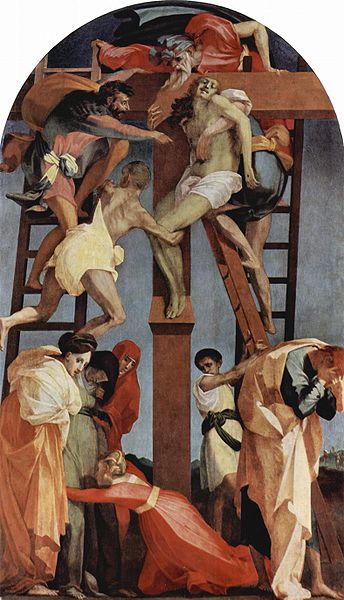
The second floor has little of interest and is inevitably an anti-climax after the Rosso Fiorentino. There are good views, however, from the windows of the little court or cloister.
Museo di Arte Sacra
This tiny three-room museum round the corner from the Baptistery contains various paintings and sculptures brought in from nearby churches, together with the usual selection of monstrances and vestments. The second room has another painting by Rosso Fiorentino, of the virgin and child between St John the Baptist and St Bartholomew, reminiscent of El Greco. The Virgin is posed in a traditional hieratic attitude, curiously contrasted with the smiling,playful Christchild on her lap.
Also worth a glance are the good terracotta bust of a bishop next to the painting, and in the next room the rather terrifying silver reliquary head of St Octavian, one of Volterra’s patron saints.
Etruscan Museum (Museo Etrusco Guarnacci)
Open every day 0900-1900 in summer and 0900-1300 in winter. Quite few of the rooms have brief descriptions of the contents in English.
The museum has one of the best collections of Etruscan remains, almost all dug up around Volterra, but it can be rather overwhelming - it contains, for instance some 600 funerary urns, rooms and rooms of them. So selectivity is essential. Most of the artefacts that have come down to us from the Etruscans (including almost everything in the museum) is connected with or taken from graves; it is not clear whether they really concentrated all their artistic skill on tombs, or whether it is just that only the tombs have survived.
Ground floor
The first two rooms, on either side of the entrance, contain the earliest stuff, including remains from the pre-Etruscan ‘Villenovan period’ and Etruscan artefacts from the l0th to 7th centuries BC. The dead were cremated and their ashes put in urns for burial. The earliest urns are mere earthenware pots with lids; already the dead were being buried with all sorts of household bits and pieces to take to the underworld.
From the end of the 7th century to the 5th century BC very little remains; there may have been a demographic decline in Volterra, or possibly one of the landslides which created ‘Le Balze’ carried away the necropolis of that period. From the 4th century to the 1st century BC (when the Etruscan civilisation was finally swallowed up by the Roman one) the arts in Volterra - or at least the arts of the tomb - flourished and the next rooms contain large numbers of funerary urns from this period. There are far too many to look at more than two or three a room. The earliest urns are in Room III, often made of terracotta and shaped like houses, the lid serving as a roof. These roof-lids were, however, soon replaced by lids surmounted by statues representing the defunct, or sometimes husband and wife together, portrayed reclining as at a banquet. Terracotta has also been replaced by stone for these urns.
Soon the body of the urn also came to be decorated, first with symbols and fantastical animals (usually griffons) as in the urns in Rooms IV and V. Then the fashion was for the dead person to be shown bidding farewell to his or her family and friends, usually with a businesslike handshake (Room VI and one end of Room VII).
The next fashion was for the dead person to be shown actually on the way to the underworld, on horsebac - the best of these urns is at the other end of Room VII (urn 121). Room VIII shows couples setting off for the underworld in covered wagons, looking rather like settlers on their way to the wild west. The more dashing (warriors and magistrates) drove themselves down in quadrigas (Room IX).
First floor
This floor contains seemingly endless urns decorated with heroic legends from the mythology that the Etruscans had by then learnt from the Romans - the urns date mostly from the 2nd or 1st century BC when Roman influence was already strong. The best urn is in Room XX, unusually for the 1st century BC made of terracotta rather than stone, and showing a beautifully modelled middle-aged couple looking tenderly at each other. This seems to be a rare example of a portrait most urns were mass-produced in the fashion of the day and the figures were stereotypes rather than faithful portrayals of the dead person.
The rooms on this floor not containing urns are stuffed with dozens of pots, bronze figurines, bronze mirrors etc (the Etruscans were masters of bronzework). The figurines are the most interesting, especially the Giacometti-like ‘Shadow of the evening’ in the middle of Room XXII. It was so named by Gabriele d'Annunzio, the 19th century poet of the Risorgimento, because of its likeness to the shadows cast by the evening light. It is thought to date from the 3rd century BC.
Rooms XXIV and XXV contain jewellery, the best in Room XXV. It mostly dates from the 4th century BC, and is imitative of the Greek jewellery of the period. Room XXX has perhaps the best-known object in the museum, the “urn of the spouses”, a 3rd century BC funerary urn depicting a husband and wife looking intently at each other.Unlike the idealized portraits of most of the urns, they look very like real people, distinctly middle-aged – the wife even has crow’s feet round her eyes.
Top Floor
This floor has a selection of the better and more sophisticated urns - perhaps those done to special order by the rich, as opposed to the more bourgeois mass-produced ‘heroic cycle’ ones of the floor below. There are particularly finely carved ones in Rooms XXIX and XXX (the last room also has a good view over the surrounding countryside). Room XXIX also shows how urns were carved, and has a particularly moving urn of a child. The urns in Room XXXII have figures on top with faces of such character that one feels that they must be portraits - although the experts tell us that this is by no means established.
The following rooms contain more bronzework and pots, including Greek-style black and orange vases. They are fairly crude: the Volterrans were obviously better at carving alabaster and stone that at making pots. After Room XXXVII there is an interesting mock-up of a tomb with rows of urns on shelves.
Churches and the Balze
For a good walk taking in a number of churches (open all day in summer) and a spectacular view, leave the Piazza dei Priori by the via Ricciarelli to the left of the Cassa di Risparmio. This leads into the via San Lino, and a little further down on the right is the church of San Lino (St Linus). He was the second pope after St Peter and allegedly came from Volterra, so he is much feted in the town. The main item of interest in the church is the 16th century tomb on the left of the altar, whose occupant sits on top looking exceptionally lively for a deceased person.
Further down there is San Francesco, the usual barn-like church of the Franciscans. There is nothing much of interest in the church itself, but in the separate chapel through the door to the right of the altar there are some spirited frescoes, well worth a look even if not of great artistic merit. They are by a local artist called Cenni di Francesco and date from 1410. The frescoes to the right of the altar and on the first bay on the right hand wall portray the usual scenes from the life of the Virgin and Christ: the Annunciation; Nativity; Adoration of the Shepherds; and Circumcision.
The rest of the frescoes portray the story of the True Cross, like Piero della Francesco’s famous cycle in Arezzo. The story starts in the right-hand lunette at the top of the second bay on the right, which shows Seth planting a branch of the Tree of Forbidden Fruit next to the body of his father Adam. The story then proceeds like a strip cartoon along the top of the walls and backwards along the bottom of the walls. In the damaged fresco above the end door the story goes fast forward to the time of the Queen of Sheba, when the tree planted by Seth has been cut down and used to build a bridge (the planks at the bottom of the fresco), the holy significance of which she recognizes. The planks were subsequently buried, but somehow rediscovered and re-used when wood was needed to build the cross for Christ’s crucifixion (on the next wall, top left). Another fast forward to St Helena in the fourth century AD finding the cross in the Holy Land (top right) and then entering Jerusalem with it (below). However, it is stolen by the wicked Persian Emperor Chosroes (in the fresco above the two windows). Back to the end wall, where Chosroes can be seen bottom left making himself adored like a god. But help is at hand: on the right the emperor Heraclius is told in a dream of the fate of the cross (on the right). Round the corner, he is seen beheading Chosroes and restoring the Cross to Jerusalem.
Go on down the road, through the mediaeval wall by Porta San Francesco and down the Borgo Santo Stefano. On the left you will pass the church of Santo Stefano. This was the parish church of the area until the late 18th century when the church of St Just, further down, was declared the parish church and the Romanesque church of Santo Stefano was pulled down, leaving only the ruins that can be seen today, together with a tiny church that was built for those who found it too difficult to get to St Just.
On a few hundred metres down the road you will come to the truly magnificent sight of the church of St Just (San Giusto), well worth the trek to the edge of the town. Its austere but majestic façade rises to the left, a great golden building against the sky, separated from the road by a long expanse of grass framed by two rows of cypresses. The present building dates from the 17th century, when it replaced an earlier Romanesque church which had been swallowed up in a collapse of the cliffs on which this part of the town is built. Four pillars from the original church stand outside, bearing the statues of four saints associated with Volterra: St Just, St Linus, St Clement and St Octavian. St Just was a sixth century Bishop who preached Christianity to the Volterrans. He made his reputation during a siege of Volterra by the barbarians when he ordered the inhabitants to throw bread down over the walls to the enemy. The latter took this gesture to mean that bread was so plentiful in the city that it could last out a siege and promptly withdrew.
The church has an austere and uncluttered classical interior, the more impressive on account of its empty spaciousness. Sadly the main paintings in the church were stolen in 2000 and now only photographs of them remain. The altar contains the bones of no fewer than five saints: the relics of St Just and St Clement are in a sarcophagous on the top, and underneath there are the remains of three early Volterran martyrs with the slightly unlikely names of Carissimo (‘Dearest’); Dolcissimo (‘Sweetest’); and Crescenzio.
Further on, at the end of the road, there is an arch in the remains of the Etruscan outer wall through which one can look down at the Balze, crumbling yellowy-grey cliffs which have collapsed on a number of occasions taking chunks of the town with them. In the hillsides beyond them, there are the remains of the old alabaster mine-workings that helped Volterra to flourish.
Roman Volterra
Volterra remained a fairly important regional centre under the Romans, and has the remains of a Roman theatre (1st century BC) and baths (1st century AD). These are best seen from above. From the main street go down via Guarnacci. At the bottom, just before the mediaeval ‘Florentine Gate’, turn up to the left for an excellent view.
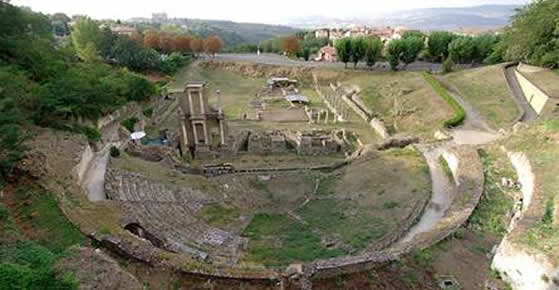
Photo via wikimedia
City Gates
Several of the old gates into the city still survive. The most famous is the Porta all'Arco, the arch of which dates from Etruscan times - the weatherworn heads on the outside are supposed to be Etruscan gods (the superstructure is Roman and mediaeval). In 1944 the German occupying forces threatened to blow up the gate to delay the allied advance. The population pleaded with the Germans not to do this and undertook themselves to block the gate with paving-stones and rubble within 24 hours - a feat which they successfully concluded as is recorded on a plaque outside the gate.
Restaurants
There are a number of restaurants and trattorie, of which none really stands out. Volterra specializes in game, so it is worth trying pasta with hare (lepre) or wild boar (cinghiale) sauce.
1994, revised 2004 and 2010
---------------------------------------------------------------------------------------------------------------------
MONTERIGGIONI
Monteriggioni and places nearby2.pdf version for downloading and printing (9 pages - includes Abbadia a Isola, Santa Colomba, Lecceto, San Leonardo and Belcaro)
A romantic looking fortified village on a hill-top just north of Siena, and various interesting sights nearby
15-20 minutes from Barontoli. Free car-park at the bottom of the hill with steps up; paying car-park at the top.
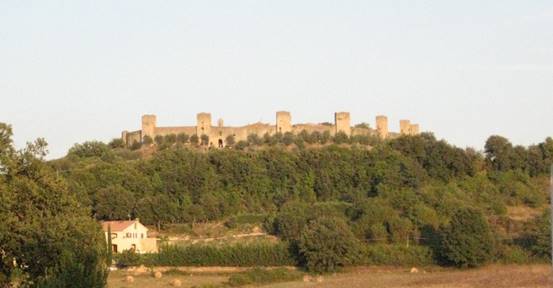
Monteriggioni looks best from below – there is a particularly good view from the Florence-Siena superstrada – with its 13th century walls surmounted by 14 towers. Its main claim to fame is that it is mentioned in Dante’s Inferno. The relevant verses are on a plaque outside one of the two gateways into the village: Dante compares the giants stationed around the ninth circle of hell to the towers crowning Monteriggioni’s walls.
Inside the walls Monteriggione is a minute mediaeval village with only a couple of streets and a small Romanesque-gothic chapel, needing only a few minutes to walk round. 30 years ago, it had no more than one tiny bar-cum-shop. But in response to the growth in tourism, the village has since been made to accommodate three bars, two restaurants, a 4-star hotel, two retail outlets for the local wine (nothing to write home about) and a number of souvenir shops. Surprisingly, none of these mars the mediaeval atmosphere.
Monteriggioni was a fortress founded by the Sienese in 1203, strategically placed on the road from Florence to serve as one of Siena’s outer defences against the constantly attacking Florentines. It had the reputation of being impregnable, and indeed did not fall until 1554, just before the final fall of Siena itself – and even then it only fell because of the treachery of the commander, who was himself of Florentine origin and - doubtless realising that Siena could not hold out much longer – betrayed Monteriggioni to the Medici in exchange for an indemnity for himself.
************************************************************************************
ABBADIA A ISOLA
A good Romanesque Abbey that was a stopping place for pilgrims on the Via Francigena
Also shown on the signs as Badia or Abbazia (all words for abbey) a Isola. From Monteriggioni, take the road towards Colle Val d’Elsa (left just before the superstrada). After a few hundred yards, turn left again. The abbey is a little way along on the left through an arch opposite a petrol station. To visit, ring the bell (marked in English) of the custodian’s house, which is on the right down the little alley just inside the arch to the right.
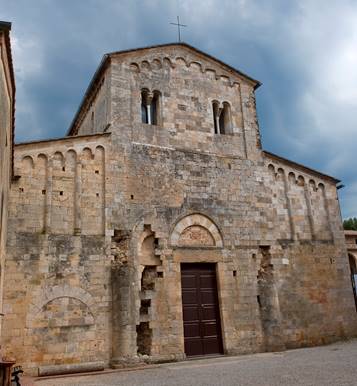
Photo via wikipedia
The abbey was founded in 1001 as a stopover place for pilgrims on the Via Francigena, the great mediaeval pilgrimage route from Northern Europe down to Rome and – for the really ambitious – on to Brindisi in the south to embark on a boat to Jerusalem.
The site is mentioned in the travel diary of Sigeric, Archbishop of Cantebury, who made a pilgrimage along the route in 990. The name Isola (island) probably comes from the fact that it was built on high ground in an otherwise swampy area. The abbey church is now almost all that remains, and is a beautifully proportioned 11th century structure built of attractive white stone, with good carvings on the blind arcading at the top of the facade, and an elegant basilican interior with three apses. There is a capital carved with primitive figures to the right of the altar
which may pre-date the church, and a pretty baptismal font near the door, with a carving of the baptism of Christ and dated 1419. The remains of the old cloister can be seen to the right of the church.
The church used to contain a possible early Duccio of the Virgin and Child (although now attributed to an unknown master), extremely beautiful. This was removed to the Museo Civico in Colle Val d’Elsa in the 1980s, and all the church retains is a photograph. However, there remains a tryptich by Sano di Pietro over the altar and some 15th century frescoes on the side walls. On the left hand side there is a large fresco of the Assumption of the Virgin, a huge crowd of saints gathered below to speed her on her way. Doubting Thomas is shown holding up the belt she dropped down to him to prove that she was real. Her tomb is shown at the bottom full of roses – which is what Thomas found when he checked the tomb to see if she had really left it. The painting is by is by Vincenzo Tamagno.
Nearer the door the same artist has left a well preserved fresco of St Blaise clutching the fearsome-looking iron wool-comb affair that he was tortured with.
There is also an alabaster baptismal font dated 1419 by an unknown Sienese sculptor; and in the apse to the right of the altar in a glass case a stone container that probably started life as a 1st century BC Etruscan or Roman funerary urn. It was re-used by the monks as a reliquiary for the relics of St Cirino, a somewhat obscure saint who along with St Salvatore is the patron of the abbey church.
There is a little settlement hidden away down the steps to the left of the church, which usually has a restaurant or two open.
1994; revised 2003, 2013 and 2020.
***********************************************************************************
SANTA COLOMBA
A village with a villa, church with frescoes, good views and good walks, about 15 km north-west of Barontoli.
From Barontoli, drive to Volte Basse and, at the main road turn right and then almost immediately left, following the signs for Firenze until after about 6 kilometres when you take a turning to the left sign-posted Santa Columba. After a few kilometres, there is a road to the right up (sign-posted) to the village.
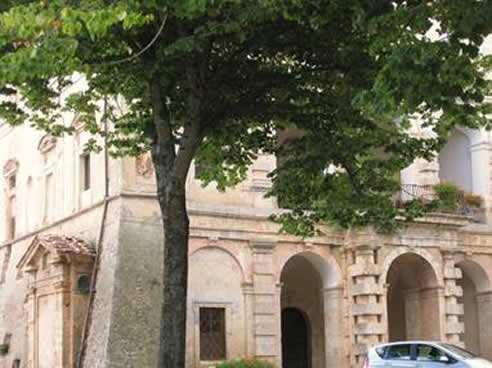
Santa Colomba is a very small village with a large and handsome villa at the entrance. It must have been important as a strong point in the past, as it had a fortress that was twice sacked in Sienese wars, the first time in 1364 by the soldiers of that great English mercenary or condottiere John Hawkwood, known in Italy as Giovanni Acuto. The fortress was left in a ruinous state, but at the turn of the 15th and 16th centuries Baldassarre Peruzzi (1481-1586), the most famous Sienese architect of his day, turned it into a gracious country house, installing a handsome spiral staircase inside. Only the massive stone base at the side of the building still hints at its more warlike past. After its completion in 1512 it became the summer residence of the Petrucci family, then the rulers of Siena. The façade was slightly remodelled in the 17th and two enormous and uninteresting wings were added in the 18th century. It is privately owned and the inside cannot be visited, but the handsome façade can be admired from the road.
The Romanesque church, on the other side of the road from the villa, looks rather small and boring from outside, but inside it is surprisingly spacious and contains some interesting remains of frescoes attributed to the early painter Segna di Bonaventura (active 1298-1331). A very faded Nativity can just be made out on the left, with the shepherds and their flocks and a huge sheepdog, and angels at the top. There is a better preserved crucifix on the right of the altar.
For good views, drive through the village and on up the dirt track. The road goes past the village cemetery and a number of villas – mostly old farmhouses recently restored and now either inhabited by the bourgeoisie of Siena or rented out as holiday lets. The road ends after a kilometre or so in a group of farmhouses. On clear days, looking back towards the village, there are fine views of Siena, and indeed of the whole plain to the south of Siena, including San Rocco and Barontoli. There are also often good wildflowers and butterflies.
For a wander in the Montagnola, the mountainous area to the south-east of Siena, park near the group of farmhouses at the end and walk up to the right between the two groups of farm buildings into the wood where there is a track that winds on up for miles.
1985. Revised 2012.
************************************************************************************
EREMO DI LECCETO
A tiny Augustinian monastery in the woods, about 7 km from Barontoli.
From Barontoli go to Volte Basse; turn right into the main road and then immediately left along the road signposted ‘Firenze’ and ‘Bivio SS 2’. Carry on along this road until you see the yellow sign to Lecceto on the left.
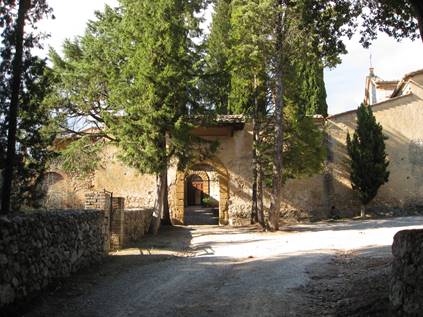
Entrance to the hermitage
Founded on the site of a hermitage in among the holm oaks (lecce in Italian), the present buildings date back mainly to the 14th century. They are not particularly distinguished architecturally, but are pleasingly simple and their lovely woodland setting makes this a most attractive place, well-suited to the contemlative life led by its community of Augustinian hermit-monks from the 14th to the 18th centuries. It attracted Augustinian frars from all over Europe, a 14th century Englishman, William Flete. In 1359, when he was about to attain his Master of theology degree at Cambridge, Flete decided to discontinue his studies at Cambridge and to go to Lecceto and give himself over completely to a life of prayer. He stayed there for the rest of his life and became famous for his spirituality.
Like so many monasteries, Lecceto was suppressed in the Napoleonic era and fell into ruin. In 1968, however, the monastery was restored and a community of Augustinian nuns moved in. They are still there, so it is a working religious establishment.
The inside of the church was completely redecorated in baroque times, and is none the less attractive for that, being white and light. Unfortunately, some good 14th century frescoes were sacrificed to achieve the baroque effect, and now only a few frescoed fragments, a couple of which (including a Michael the Archangel) may be by Ambrogio Lorenzetti. The largest fresco , by an unknown 14th century Sienese artist, shows four saints – St Augustine, St John the Baptist, an unknown bishop and St Nicholas of Tolentino (with a sun on his front). On the same wall, near the altar, there is a modern portrait of St Augustine with his mother St Monica, in sharply contrasting style.
An elegant 14th century marble tombstone is set in the floor on the right, its peacefully sleeping owner (a Sienese nobleman called Niccolò Saracini who asked to be buried there) reposing on a beautifully embroidered marble pillow.There is a similar marble tomb on the other side; unfortunately, both are difficult to see because of the benches that have been placed on top of them. Above the altar on the right wall there is a curious painting of a crucifix standing on three symbolic mountains, with holm oak branches sprouting above, surrounded by portraits of monks from the monastery who had achieved the status of “blessed” (one below sainthood).
An ancient two-story cloister stands beside the church, very simple and peaceful, the sort that makes one understand why people take up the monastic life. There is a marble slab in this cloister commemorating a visit that St Augustine is supposed to have made to Lecceto in the year 400 – a historical impossibility as he was living in Africa at the time. There is also a second cloister with intersting frescoes, but it is closed to the public..
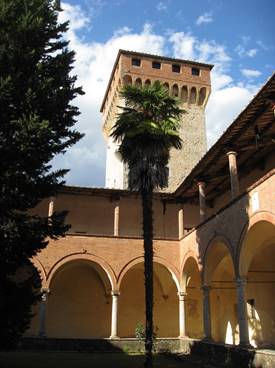
Cloister and tower
For more on the monastery, see the Augustinian Order’s website http://www.augnet.org/en/history/places/4231-italy-lecceto/.
Lecceto is a favourite afternoon outing for local people, so at weekends it is often quite crowded. There are some pleasant walks in the surrounding woods.
1990s and 2021
*****************************************************************************
EREMO di SAN LEONARDO al LAGO and the PYRAMID
An ancient hermitage with good frescoes; plus a walk to a strange memorial.
SAN LEONARDO al LAGO and the PYRAMID.pdf version for downloading and printing (3 pages)
About 10km from Barontoli. Open 9.30-15.30 except Mondays. From Barontoli go to Volte Basse; then right and almost at once left. Follow the signs for Firenze until you see a left turn with a sign indicating San Lorenzo al Lago. Go along this road for a couple of kilometres (it ceases to be tarred about half way along); then left again up a rather bad track. For access, ring the bell for the custodian.
San Leonardo once overlooked a lake (drained in the middle of the last century), hence the name 'al Lago' (on the lake). It is thought to be the oldest hermitage in Tuscany and may well have begun when a singly monk took up residence in a cave there, perhaps as early as 800 AD. A document dating from 1168 records that a monk called Benedict built a church there, probably in the 11th century, dedicated to St Leonard. Benedict is generally regarded as the founder. He would have gathered a small group of monks about him to live in solitude.
The hermitage became fashionable when one of Siena’s favourite holy men, Blessed Agostino Novello, Prior-General of the Augustinian Order, decided to retire to San Leonardo, dying there in 1309. Various local magnates endowed the little monastery with land; the church was rebuilt in the gothic style; and good artists employed to provide suitable frescoes. The complex was heavily fortified in 1366, a time of unrest, to provide a place of refuge for the inhabitants of the neighbouring village of Santa Colomba. Later the monastery went into decline and it was officially closed in 1782. All that now remains is the little monastery church, with the remains of the monk’s original chapel in the crypt, the old refectory and some remains of walls.
The old refectory has what must once have been a powerful semi-monochromatic fresco of the crucifixion by the fifteenth century Giovanni di Paolo (1399-1482), unfortunately damaged as at some point when a ceiling was built half way up the refectory right through the middle of it. Only the heads of the crucified men can be seen, together with part of the figures at the foot of the cross can still be seen, women to the left and men (including some orientally dressed Pharisees) to the right.
The small Romano-Gothic church is decorated with attractive frescoes by the Sienese artist Lippo Vanni, painted between 1360 and 1370, the larger scenes demonstrating a good use of space and perspective. Those round the altar show scenes from the life of the Virgin: her presentation at the temple as a child; the Annunciation; and her betrothal to Joseph, apparently by the same priest as the one to whom she was presented earlier. In the vault, on the sides, Vanni has painted a wonderful heavenly orchestra of angels, playing a strange array of instruments.
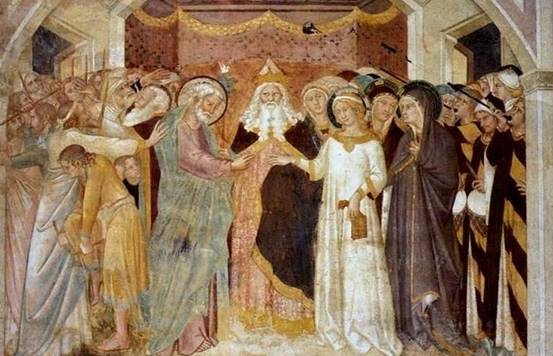
Detail of Lippo Vanni’s fresco of the betrothal of the Virgin.
On the left of the entrance to the chancel there a picture of San Leonardo himself, with, below, some illustrations of the miracles which he performed. St Leonard was a Frankish noble who converted to Christainity and became a hermit near Limoges, becoming renowned for his sanctity and the miracles that he performed. Here as often the case with Sienese saints and holy men, he has been credited with the capacity to fly like Superman through the air to spots where his miraculous aid was needed (cf. Simone Martini's painting of the blessed Agostino Novello in the Pinacoteca in Siena).
The fresco on the right depicts St Augustine of Hippo in his bishop’s robes (above) and in a garden at the moment of his conversion to Christianity (below) – he heard a heavenly voice saying “take up and read”, which he interpreted as a divine instruction to read the Bible, shown on his lap. His mother St Monica prays nearby and a divine hand can be seen pointing down from the clouds above.
The Pyramid
A track leads into the wood beside the little car-park below the monastery, sign-posted “La Grande Traversata Osteraccia”. Follow this, taking a left fork after 150 metres. After a pleasant walk of about half a mile it brings you out onto the road below the monastery, by a little settlement called “Osteraccia” – probably an inn (“osteria”) in medieval times. On the other side of the road, to the right of the house and garden, another path leads down through the wood sign-posted “La Grande Traversata Piramide” (now part of the via Francigena). This comes out into a field, and on the other side of the field is the “pyramid” – actually more of an obelisk. It stands incongruously in the middle of nowhere to commemorate the draining of the lake that used to cover the area. In medieval times, it seems to have been a true lake, its fish and waterfowl providing a useful source of food for the local inhabitants. But by the 18th century it had become a malodorous swamp, blamed by the neighbouring villages for bringing sickness (these were the days when malaria was blamed on “miasmas” rather than to the mosquitoes that no doubt infested the swamp). A local noble undertook to drain the swamp at his own expense in 1764, and built a tunnel to take the waters to the river Merse. But he failed to complete the work. Fortunately, the then Grand duke of Tuscany, the Austrian Peter Leopold of Habsbourg (who had inherited the Duchy of Tuscany from the last of the Medicis), was an enlightened ruler and he took over the project, completing it in 1781. The pyramid was built to celebrate the event.
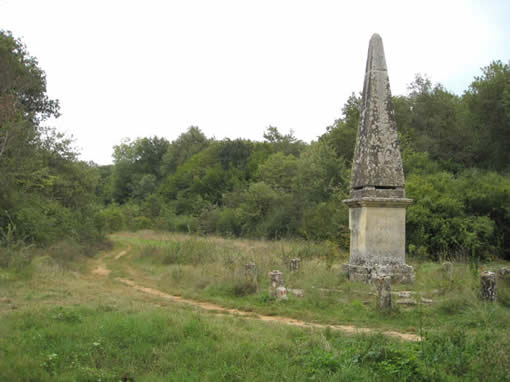
There is a small picnic area nearby with a table and a minatory notice forbidding everything from lighting fires to making unnecessary noise.
1995; revised 2005.
***********************************************************************************
CASTELLO DI BELCARO
An attractive fortified villa just outside Siena, still privately owned.
Open to the public for free the first Monday of every month (closed over the lunch period). From Barontoli, take the old road to Siena through San Andrea and Costalpino. Turn left just after Costalpino, following the yellow signs to Castello di Belcaro.
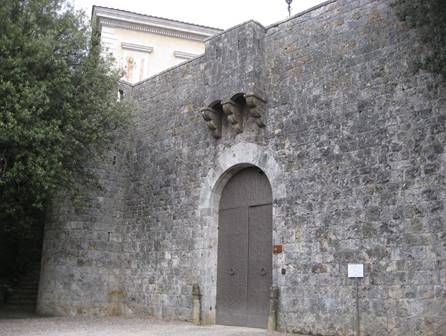
The fortified gate into Belcaro
Belcaro was originally built as a castle in the 1100s, but was sacked a number of times; substantially remodelled as a villa in the 16th century by the fashionable architect of the day, Baldassare Peruzzi; and further altered on several occasions since then. So it is hardly an architectural unity, but still a fine example of a castle-villa built both for defence and for gracious living. The villa is still entirely surrounded by high walls.
It has been owned during its long history by various leading Sienese families, including the Salimbeni (whose unpopularity caused the populace to rise up and attack Belcaro); St Catherine of Siena who turned it into a convent in 1376; the Turamini (who were responsible for employing Peruzzi to rebuild it); and since 1710 the Camajori, the present owners. The name is said to come from a rather upsetting story. A lady of the Castello, waiting for her husband to come back from the wars, was promenading on the battlements with her baby in her arms, when she perceived her husband coming over the horizon. She extended her arms towards him, dropping the baby into the garden below. This led her to exclaim to her husband “you are handsome (bello) but you have cost me dear (caro)”.
There is an outer courtyard immediately inside the main gate and then an inner one with the villa on the left. At ground floor level there are the main working rooms of the establishment - winery, huge ancient kitchen etc. An arch leads into a simple but attractive formal garden with a small chapel, to the left of which there is a painted loggia.
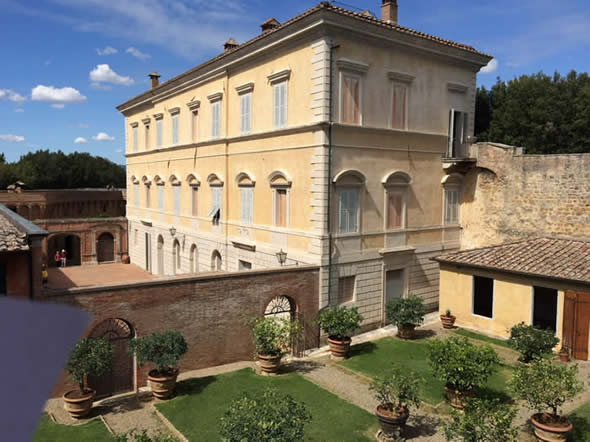
The villa at Belcaro and part of the garden, viewed from the battlements
One cannot visit the villa itself, but the chapel is open and has some quite good frescoes dating from the 16th-17th century. In the apse, St Peter stands to the left of the altar clutching a giant key and St Paul with his sword on the right. On either side of the Virgin, from left to right, the saists are St Catherine of Siena with her lilies; St George; St Christopher carrying the Christchild; and St Catherine of Alexandria with the broken wheel on which they tried to martyr her.
The loggia next to the chapel is decorated with totoally unreligious and particularly beguiling frescoes of Greek gods and goddesses and birds and anumals.
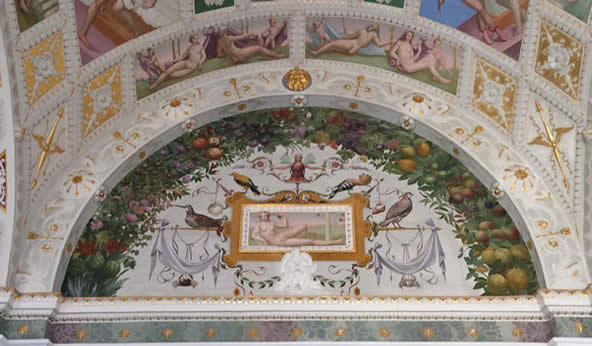
Fresco in the loggia at Belcaro
There are steps up to the battlements, around which you can walk and admire stunning views of Siena and surrounding countryside (the entrance to the battlements is just inside the second courtyard; on the way up there some cannon balls in wall from an unsuccessful Medici siege of the Castello). At one end you can peer through a glass door into the Arms Room of the villa. There is also a fresco of the Judgement of Paris painted by Peruzzi inside the private part of the villa, not normally viewable.
1980s, revised 2015 and 2017.
--------------------------------------------------------------------------------------------------------------------------
CASOLE D'ELSA AND MENSANO
Two small and ancient towns south of Colle Val d'Elsa, of moderate interest only, but worth a look if you are passing by.
Casole d'Elsa
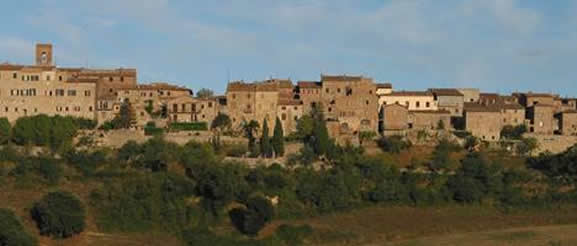
Casole d'Elsa is worth visiting for its Collegiata (church), which has some interesting paintings and sculptures.Traffic is restricted within the tiny hilltop centre, but from the main car-park below the town (paying except on Sundays), there are a series of lifts to the top. It was originally an Estruscan settlement and its oval-shaped miaeval city walls probably replaeced earlier Etruscan ones.
The main square contains both the Collegiata della Assunta and a small museum. The church was originally Romanesque and retains its Romanesque doorway. But the wide interior was gothicised in the 15th century, imparting an impression of light and space, with great pointed arches over the main altar and the chapels on either side of it. The church was damaged in the Second World War, but has been well restored.
On the wall of the right hand nave, just beyond the entrance, there is a particularly attractive early 16th century terracotta relief of the Nativity and the Adoration of the Shepherds; a light beside it can be turned on, but it is still infuriatingly difficult to see. Further along, there is a fine early 14th century funerary monument by Gano da Siena to Bishop Tommaso Andrei, a scion of one of the two main families in Colle at that period. Opposite, another (early 1300s) funerary monument high on the wall commemorates “Messer Porrina”, a leading member of the other family, the Beltrami or Albertini. It also was thought to be by Gano da Siena. But the main expert on Sienese art, Giovanni Previtali, recently decided that it, and various other works in Siena and elsewhere, are by a hitherto neglected late 13th and early 14th century artist called Marco Romano – as his name indicates, an itinerant sculptor from Rome. The Beltrami family apparently gave him their patronage, and Casole is making much of Previtale’s discoveries.

Terracotta relief at Casole d’Elsa
High above the altar some remains of Duccio-period frescoes of the Last Judgement can be made out. There are further frescoes of the same period in a little chapel of the left aisle, including a Maiestà with Beltrami donors painted at the bottom.
Next to the church there is a tiny museum in the old cloister (open 10.00-12.00 and 16.00-19.00 except Monday), with the usual collection of local Etruscan finds and second-rate paintings, not really worth visiting. If you do go in, there is rather a good scene on an Etruscan vase on the first floor showing a satyr chasing a Maenead trying to wash herself, and an unusual 2nd century BC Etruscan tomb of a terracotta lady lying fully stretched out as if in sleep. The paintings of most interest are probably two taken from the church: a Virgin and Child with Massacre of the Innocents by Andrea di Niccolo; and opposite a Madonna and Saints (a particularly soupy-looking St Sebastian) by Giacomo Pacchiarotti (1520).
Half way down the main street (turn left on leaving the church) on the right is the former Palazzo Pretorio or Palacxe of the Governor, with a fine selection of coats of arms belonging to the various holders of that office.
At the botttom of the main street is the well restored little "Rocca" or fortress, now used as municipal offices - note the immense thickness of the walls, more than two metres. Pity also the less able of Casole’s residents who have to climb two extremely steep flights of steps to get to see the local officials on the upper floor.
Casole has its own mini-palio, usually held on the second Sunday of May. The race was originally held in May, on the festival of S. Isidore, the patron saint of farmers, and the competition was between the various tenant farms attached to the main estate. In the 1950s and 1960s there was an agricultural crisis in Italy, with consequent depopulation of the countryside, and palio ceased to be held. It started again in 1976, and from being a spring festival for agricultural workers has now become a big summer celebration, attracting thousands of Italian and foreign tourists.
Mensano
Mensano is barely more than a village, but still has mediaeval walls and a castle. It is chiefly interesting for its 12th century church, San Giovanni Battista, an attractive Romanesque basilica with alabaster windows and large interesting capitals on the monolithic columns in the nave, carved with the usual fantasy of leaves, primitive heads and strange animals. These are probably the best carved Romanesque capitals in the whole of the Province od f Siena. There are light switches behind the columns near the altar in the side aisles.
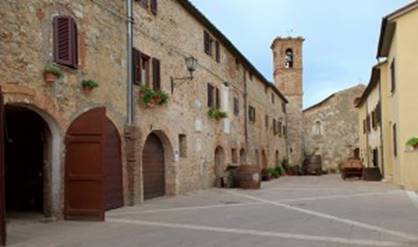
View towards the church

Sheep on a carved capital at Mensano.
1993 revised 2005, 2010 and 2021